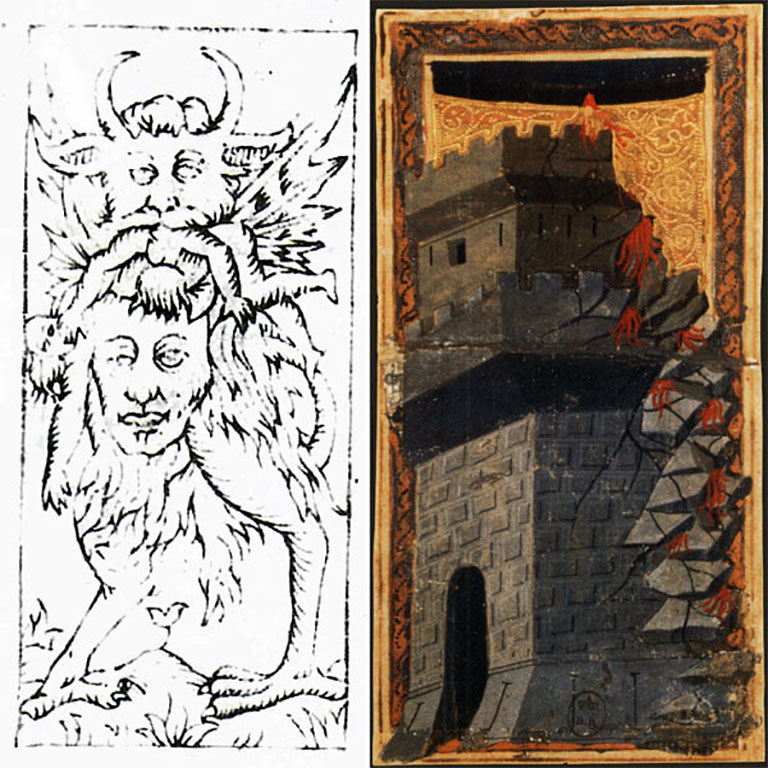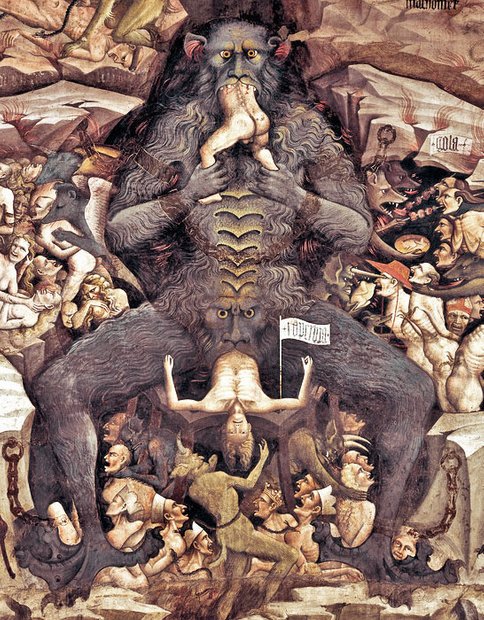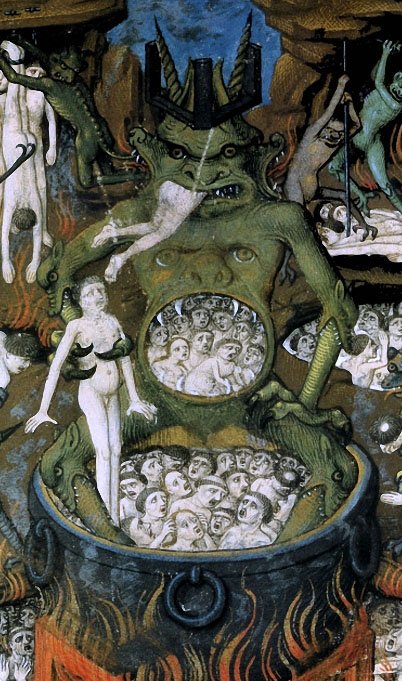THE TAROT WHEEL
Not one single card depicting the Devil survived in the handcrafted decks. And still, it is there, where in the new structure, started the Ascent to Light, in the deepest darkest places of Hell. The card represented on in the figure here above is from an uncut sheet conserved in the collection of Edmond de Rothschild in the Louvre in Paris, dated to the end of the 15th Century. The card is from a deck with illustrations typical for a Tarocco di Bologna. The Devil is shown as a hairy monster with bat wings, horns, bird claws, and a second face on his stomach. The meaning of the second face on his stomach is that his center of intellects serves his lowest appetites. He is devouring a human Soul.
This representation of the Devil is typical for the Middle Ages and the early Renaissance. The Devil symbolizes the worst of the worst, maybe the reason why none of these cards survived. Given the talent of the artists who created the handcrafted decks, these cards must have been really frightening. A typical example of the devil in religious art in the Middle Ages is represented here at right. This image comes from a French translation of a manuscript of St Augustine, De civitate Dei libri XXII (book 22 of the city of God), The translation, conserved in the French National Library, dates from the third quarter of the fifteenth Century.
On the same fresco dated to 1410 in the San Petronio cathedral in Bologna, as the one where we found the image of the Hanged Man, there is also an image of the Devil eating Human Souls with both of his heads (see the figure here below). Remark that the human souls in hell are always illustrated being naked. This is to symbolize that in Hell the human soul is deprived of everything
In the Estensi deck, the card shown here above at the right of the Devil shows a tower crumbling down. The same image can also be found on all uncut sheets dating from the end of the 15th or the beginning of the 16th Century. The Tower has been struck by the lights of Heaven. The card was called “il Sagitta”, or lightning. It was symbolizing the Anger of God, its lightning destroying all evil things on Earth. Again we have here a direct reference to the Bible, to the Apocalypse at the end of times. In the Divina Commedia of Dante, his words were poetic, helping to accept the horrible things he was describing. But on the Trionfi decks, these horrors were visualized. The images were difficult to look at, and not one of them survived time. Except the Tower of the Estensi deck.
With all these frightening images of the Hell, Devil and God's Anger, it is without surprise that this card was not very popular among the Italian Nobility. Most of them did not live exactly like a Saint, and if any people were deserving Hell, there was a good chance that they would be among them.
The relation between the two cards is clear, the Hell and the Anger of God are belonging together. They form the Darkness of the Underworld, the first pair of cards in the Ascent to Light.
The Bible text to which the Tower is referencing can be found in Revelation 16: 17-19
17. And the seventh angel poured out his vial into the air ; and there
came a great voice out of the temple of heaven, from the throne,
saying, It is done.
18. And there were voices, and thunders, and lightnings ; and there was
a great earthquake, such as was not since men were upon the earth,
so mighty an earthquake, and so great.
19. And the great city was divided into three parts, and the cities of the
nations fell : and great Babylon came in remembrance before God,
to give unto her the cup of the wine of the fierceness of his wrath.
PAIR 1 - THE DARKNESS OF THE UNDERWORLD




